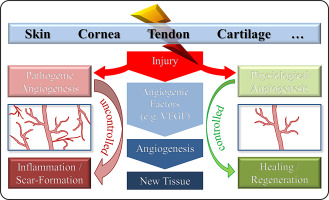当前位置:
X-MOL 学术
›
Adv. Drug Deliver. Rev.
›
论文详情
Our official English website, www.x-mol.net, welcomes your
feedback! (Note: you will need to create a separate account there.)
Limiting angiogenesis to modulate scar formation.
Advanced Drug Delivery Reviews ( IF 15.2 ) Pub Date : 2018-03-03 , DOI: 10.1016/j.addr.2018.02.010 Stefanie Korntner 1 , Christine Lehner 1 , Renate Gehwolf 1 , Andrea Wagner 1 , Moritz Grütz 1 , Nadja Kunkel 1 , Herbert Tempfer 1 , Andreas Traweger 1
Advanced Drug Delivery Reviews ( IF 15.2 ) Pub Date : 2018-03-03 , DOI: 10.1016/j.addr.2018.02.010 Stefanie Korntner 1 , Christine Lehner 1 , Renate Gehwolf 1 , Andrea Wagner 1 , Moritz Grütz 1 , Nadja Kunkel 1 , Herbert Tempfer 1 , Andreas Traweger 1
Affiliation

|
Angiogenesis, the process of new blood vessel formation from existing blood vessels, is a key aspect of virtually every repair process. During wound healing an extensive, but immature and leaky vascular plexus forms which is subsequently reduced by regression of non-functional vessels. More recent studies indicate that uncontrolled vessel growth or impaired vessel regression as a consequence of an excessive inflammatory response can impair wound healing, resulting in scarring and dysfunction. However, in order to elucidate targetable factors to promote functional tissue regeneration we need to understand the molecular and cellular underpinnings of physiological angiogenesis, ranging from induction to resolution of blood vessels. Especially for avascular tissues (e.g. cornea, tendon, ligament, cartilage, etc.), limiting rather than boosting vessel growth during wound repair potentially is beneficial to restore full tissue function and may result in favourable long-term healing outcomes.
中文翻译:

限制血管生成以调节瘢痕形成。
血管生成是从现有血管中形成新血管的过程,实际上是每个修复过程的关键方面。在伤口愈合期间,形成了广泛但不成熟和渗漏的血管丛,随后由于无功能血管的退化而减少了血管丛。最近的研究表明,过度的炎症反应导致血管生长不受控制或血管退化受损,会损害伤口愈合,从而导致瘢痕形成和功能障碍。然而,为了阐明可促进功能组织再生的靶向因子,我们需要了解生理血管生成的分子和细胞基础,从诱导到血管的分辨。特别是对于无血管组织(例如角膜,腱,韧带,软骨等),
更新日期:2019-11-05
中文翻译:

限制血管生成以调节瘢痕形成。
血管生成是从现有血管中形成新血管的过程,实际上是每个修复过程的关键方面。在伤口愈合期间,形成了广泛但不成熟和渗漏的血管丛,随后由于无功能血管的退化而减少了血管丛。最近的研究表明,过度的炎症反应导致血管生长不受控制或血管退化受损,会损害伤口愈合,从而导致瘢痕形成和功能障碍。然而,为了阐明可促进功能组织再生的靶向因子,我们需要了解生理血管生成的分子和细胞基础,从诱导到血管的分辨。特别是对于无血管组织(例如角膜,腱,韧带,软骨等),











































 京公网安备 11010802027423号
京公网安备 11010802027423号